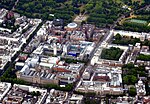Ceilings of the Natural History Museum, London

A pair of decorated ceilings in the main Central Hall (officially Hintze Hall since 2014) and smaller North Hall of the Natural History Museum in South Kensington, London, were unveiled at the building's opening in 1881. They were designed by the museum's architect Alfred Waterhouse and painted by the artist Charles James Lea. The ceiling of the Central Hall consists of 162 panels, 108 of which depict plants considered significant to the history of the museum, to the British Empire or the museum's visitors and the remainder are highly stylised decorative botanical paintings. The ceiling of the smaller North Hall consists of 36 panels, 18 of which depict plants growing in the British Isles. Painted directly onto the plaster of the ceilings, they also make use of gilding for visual effect. The natural history collections had originally shared a building with their parent institution the British Museum, but with the expansion of the British Empire there was a significant increase in both public and commercial interest in natural history, and in the number of specimens added to the museum's natural history collections. In 1860 it was agreed that a separate museum of natural history would be created in a large building, capable of displaying the largest specimens, such as whales. The superintendent of the natural history departments, Richard Owen, envisaged that visitors would enter a large central hall containing what he termed an "index collection" of representative exhibits, from which other galleries would radiate, and a smaller hall to the north would display the natural history of the British Isles. Waterhouse's Romanesque design for the museum included decorative painted ceilings. Acton Smee Ayrton, the First Commissioner of Works, refused to permit the decoration of the ceilings on grounds of cost, but Waterhouse convinced him that provided the painting took place while the scaffolding from the museum's construction was still in place it would incur no extra cost; he further managed to convince Ayrton that the ceiling would be more appealing if elements of the paintings were gilded. The ceiling of the Central Hall consists of six rows of painted panels, three on each side of the roof's apex. Above the landing at the southern end of the building, the ceiling is divided into nine-panel blocks. The uppermost three panels in each block consist of what Waterhouse termed "archaic" panels, depicting stylised plants on a green background. Each of the lower six panels in each block depicts a plant considered of particular significance to the British Empire, against a pale background. Above the remainder of the Central Hall the archaic panels remain in the same style, but each set of six lower panels depicts a single plant, spreading across the six panels and against the same pale background; these represent plants considered of particular significance either to visitors, or to the history of the museum. The ceiling of the smaller North Hall comprises just four rows of panels. The two uppermost rows are of a simple design of heraldic symbols of the then constituent countries of the United Kingdom; each panel in the lower two rows depicts a different plant found in Britain or Ireland, in keeping with the room's intended purpose as a display of British natural history. As the ceilings were built cheaply, they are extremely fragile and require regular repair. They underwent significant conservation work in 1924, 1975 and 2016. The restoration in 2016 coincided with the removal of "Dippy", a cast of a Diplodocus skeleton which had previously stood in the Central Hall, and the installation of the skeleton of a blue whale suspended from the ceiling.
Excerpt from the Wikipedia article Ceilings of the Natural History Museum, London (License: CC BY-SA 3.0, Authors, Images).Ceilings of the Natural History Museum, London
Cromwell Road, London Brompton (Royal Borough of Kensington and Chelsea)
Geographical coordinates (GPS) Address Website Nearby Places Show on map
Geographical coordinates (GPS)
| Latitude | Longitude |
|---|---|
| N 51.496111111111 ° | E -0.17638888888889 ° |
Address
Natural History Museum
Cromwell Road
SW7 5BD London, Brompton (Royal Borough of Kensington and Chelsea)
England, United Kingdom
Open on Google Maps









